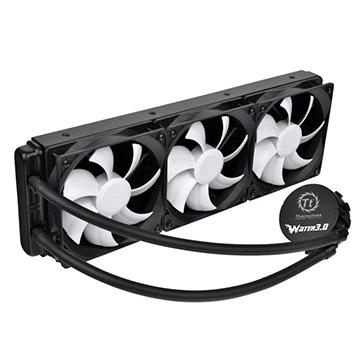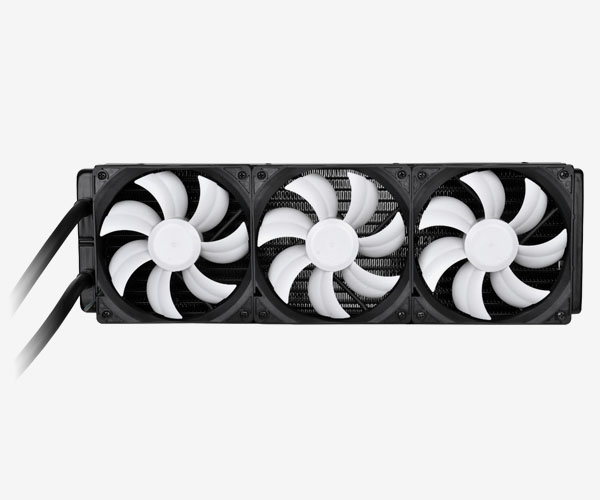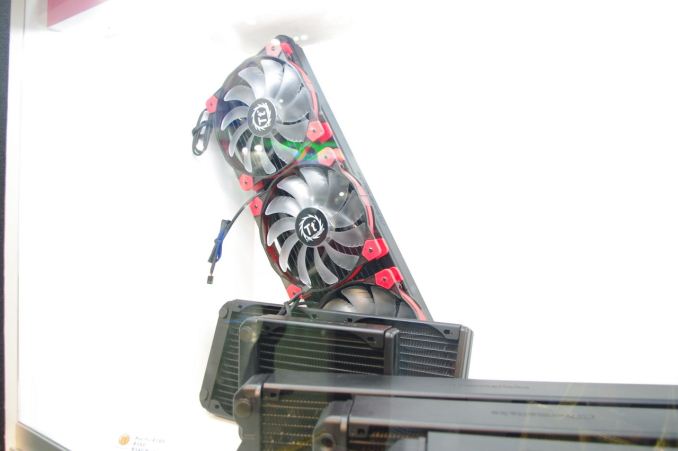Thermaltake Goes Big: Water 3.0 Ultimate CLC Launched, 3x120mm
by Ian Cutress on August 4, 2014 10:00 AM EST- Posted in
- Cases/Cooling/PSUs
- Thermaltake
- Water Cooling
- Water 3.0

Truth be told, I am a fan of closed-loop liquid cooling systems. While they might be more expensive than air coolers of similar performance, they tend to be quieter, less bulky and use fan mounts already in the case. What Thermaltake is doing with the new Water 3.0 Ultimate seems to be providing the bulkier solution with better cooling for users with larger cases. The Water 3.0 series, from Performer to Extreme, uses the standard sized CLC configurations and the new Ultimate takes on the 3x120mm form factor with relatively little competition.
In liquid cooling systems, longer radiators mean a longer retention time for the liquid to cool down. Custom loops, especially those dealing with multiple components (CPU + GPU, or >2 GPU) use either longer radiators, thicker radiators or more radiators to help generate this delta. In some cases, radiators are put between the two hot components to maximize the delta of cooler air coming in. The downside of more radiators is resistive pressure in the system, so it helps to have a pump to compensate. Thermaltake is not quoting the efficiency or flow rate of the pump, but do have it listed at 3600 RPM. Each of the three fans included with the Water 3.0 Ultimate is rated for 99 CFM at 20 dBA, but no static pressure (the key figure in pushing air through a restrictive medium) is quoted.
All modern sockets are supported (1150/1155/1156, 1366, 2011-0/2011-3, AM2/AM3/FM1/FM2), and I can imagine that this unit has a price premium over the more common 2x120mm configuration. We have no pricing information as of yet but will update when we do.
Note that Thermaltake is not averse to large water cooling systems: we spotted this 3x180mm radiator for custom loops at Computex this year:
Now, I wonder what a CLC version of that would cost.
Source: Thermaltake



















7 Comments
View All Comments
asendra - Monday, August 4, 2014 - link
And I built a mITX gaming box, guess that's not gonna fit LOL.Ian, given that you are a fan of CLC, which CLC do you currently use?. I'm looking for a single 12~14mm fan, to put in a push-pull config in my node 304 case (4770K cpu). I'm leaning on a Hydro H90 at the moment.
HisDivineOrder - Monday, August 4, 2014 - link
Really wish these companies were selling these things optionally without fans. Most of us already have ideas about what fans we'll use and I'd say that's especially true with an already niche tri-120mm setup.NeonFlak - Monday, August 4, 2014 - link
At one point I had 2 Thermaltake Water Pros. Both failed in less then year. Both failures caused problems with other items. Thermaltake did not cover any of it, nor did they replace either of the coolers. Which are both still sitting on a table in the basement. And those failures have me slowly switching everything back to air coolers.darckhart - Monday, August 4, 2014 - link
Soo... do they advertise that users can expand the loop to cool other components? do they provide instructions how? do they suggest other components one may need to purchase? otherwise a triple rad seems a tad overkill for just the cpu...DanNeely - Monday, August 4, 2014 - link
The entire point of CLCs is that everything is sealed so you can't screw anything up messing with it. I'm hoping this was designed around bigger allowing slower quieter fans for the same amount of cooling; in the attempt to make a silent solution. Not bigger is better marketing BS; because only the most extreme OC is going to be pushing enough heat for a 360 rad to give a meaningful benefit to a CPU only loop. Unfortunately the lack of any mention about it being quieter/silent in the marketing makes me suspect it's marketoid BS driven.Treynolds416 - Monday, August 4, 2014 - link
Those hoses look barely long enough... It would be wise to check those dimensions against your case before buyingdanjw - Monday, August 4, 2014 - link
Thank you for calling them out on the lack of a static pressure spec. The other information is useless and that is the only spec that really matters when blowing into of out of a heatsink or radiator.